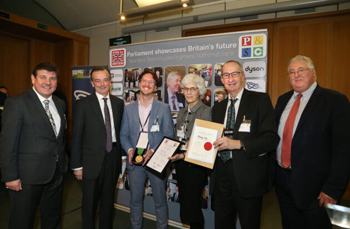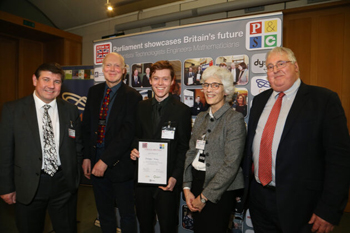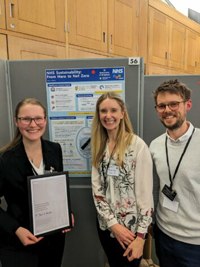
Mathematics met politics this week, when twenty mathematicians headed to Houses of Parliament for the STEM for BRITAIN awards 2023. In this annual event early career researchers in maths, engineering, the biological and biomedical sciences, chemistry, and physics are invited to submit posters explaining their work. A total of 120 of them are then chosen across all subjects for a poster exhibition in parliament, and a panel of expert judges chooses three medalists for each discipline.

From left to right: Chris Hickey (bronze award), Arkady Wey (gold award), and Jenny Power (silver award).
"This annual competition is an important date in the parliamentary calendar because it gives MPs an opportunity to speak to a wide range of the country's best young researchers," said Stephen Metcalfe MP, Chair of the Parliamentary & Scientific Committee, which sponsors the mathematics awards. "These early career engineers, mathematicians and scientists are the architects of our future and STEM for BRITAIN is politicians' best opportunity to meet them and understand their work. Given the volume of applications each year, just to have a poster in this final is an achievement. Do be proud."
The proud medallists in the mathematics categories were: Arkady Wey who won the gold award, Jenny Power who won the silver award, and Chris Hickey who won the bronze award. In addition, mathematician Julia A. Meister was awarded a bronze medal in the Dyson Sustainability Awards, the winners of which were picked from across all five categories of the competition.
One thing that all four mathematics winners have in common is that their work aims to have a direct impact on all our lives: by improving medical treatments, protecting the environment, or helping to keep us safe from disasters. The fact that maths can do this is no surprise, according to mathematician Ulrike Tillmann, Director of the Isaac Newton institute for Mathematical Sciences, which provided support to the event, and President of the London Mathematical Society. "The physicist Eugene Wigner famously commented on the 'unreasonable effectiveness of mathematics'. So when we are looking for new and powerful ideas in the new fields of data science, and we are faced with difficult problems in medicine, national security, and artificial intelligence it is more than likely that the mathematical sciences will be a fundamental part of the solution." Tillmann was speaking on behalf of the Council for Mathematical Sciences, one of the sponsors of the STEM for BRITAIN awards.
So let's have a look at the medallists' work and how it may help protect lives and the planet.
Gold: Arkady Wey

From left to right: Stephen Metcalfe MP, Martin Bridson, Arkady Wey, Ulrike Tillmann, David Bott, Viscount Stansgate.
Arkady Wey is a postgraduate student at the University of Oxford. His work focusses on filters that can sift harmful particles from gases, such as air, and liquids, such as water. It's an important topic. As Wey points out in the poster he presented, 10% of deaths worldwide are attributed to polluted air, and 6% of deaths in low-income countries are caused by contaminated water.
Filtration is a method for removing harmful particles by driving a fluid, such as water or air, through a porous membrane. Many filtration membranes are made of a material called ePTFE, which to the naked eye looks like a thin plastic film. "On the microscale, ePTFE consists of tiny fibres that are woven together randomly," Wey says on his poster. "This creates tunnels of space between fibres, called pores, through which fluid and particles can travel."
Maths comes into the picture because mathematical models of the filtration process can tell you how effective the filtration is going to be and help you optimise it. An equation from physics, called Darcy's equation, describes the flow of a fluid through a porous medium, but doesn't take into account the medium's microscopic structure, and therefore can't give sufficiently precise results.
Another approach is to represent the small-scale structure of the membrane as a network of tunnels through which the fluid and particles travel. This motion, and the way in which particles deposit on the walls of the pores they travel through, can also be described by mathematical equations. In this way, you can construct a model that can predict important properties, such as the concentration of the particles and the velocity of the fluid. The downside is that the model takes a lot of computing power to run — unsurprisingly, given the complexity of the material's microscopic structure.
Wey's poster presents an alternative way of modelling the filtration process that makes the best of both worlds: it takes into account just enough information about the microscopic structure to obtain meaningful results, but without requiring crazy amounts of computing power. This multiscale model can predict quantities like the concentration of particles and the velocity of the fluid. From these, you can then calculate useful metrics, such as the proportion of particles that are retained in the filter and the time at which the filtration is terminated, usually when the velocity slows down to below a certain speed. You can find out more about this model in Wey's poster.
"I'm surprised and thrilled," Wey said on receiving the gold award. "I'm very near to the end of my PhD, and I applied for this competition as a way of rounding off my studies and presenting my research. My main feeling is one of pride that my work has been recognised on this platform. I'm less interested in maths for maths' sake, and I want to produce something with real world, social impact. Today feels like a great success."
Silver: Jenny Power

From left to right: Stephen Metcalfe MP, Jenny Power, Ulrike Tillmann, Viscount Stansgate.
Jenny Power is a PhD student at the University of Bath. Her poster explores how a type of cancer treatment called brachytherapy can be made safer using mathematics. The treatment involves placing radioactive seeds directly on a tumour. "When the tumour is located close to organs, the radiation can damage them, causing further health complications," Power writes in her poster. So the question is where to place the radiation to minimise the damage to healthy tissue while still treating the tumour.
The idea is to help clinicians create a treatment plan for a patient, based on the results of a CT scan. Information from the scan would be fed into an algorithm which then outputs the optimal placement of the radiation seeds for treating the patient. Mathematics enters the picture because the physical laws of radiation emission are described by mathematical expressions. The problem boils down to one of optimisation. You look for a particular mathematical function that satisfies certain constraints which embody the main aims of the treatment: to make sure that the tumour gets the required dose of radiation, while surrounding tissue is protected. The result then tells you how the radiation should best be applied. You can find out more on Power's poster.
"I am a big advocate for good and effective scientific communication," Powers said. "I believe posters are a perfect medium to showcase research in a fun and accessible way. With my poster, I want to demonstrate the impact maths can have on improving the lives of people, with my work specifically focusing on healthcare, and why research in mathematical sciences is so vital."
Bronze: Chris Hickey

From left to right: Stephen Metcalfe MP, Geoffrey Grimmett, Chris Hickey, Ulrike Tillmann, Viscount Stansgate.
Chris Hickey is a computational scientist at the company Arup. His poster, sadly topical, explores ways in which buildings can be tested to make sure they can withstand earthquakes.
Again, mathematical models are essential here. Given the parameters that describe a building design, they can predict how stable a building will be: whether it can support its own weight and how it will react to vibrations, for example. Important ingredients here are again equations that come from physics, such as Newton's second law of motion, or Hooke's law, which tells you how much force is needed to compress or extend a spring.
However, since modern buildings are described by millions of variables, you end up with a very large number of equations that need to be solved to assess a building's stability. The problem is dealt with using iterative eigensolvers. "These go through the problem and produce estimates for [particular types of solutions]," Hickey writes in his poster. "They repeat over and over again, improving the estimate with each pass, until they're sufficiently accurate." However, the solutions these eigensolvers produce are not always exactly what engineers need to know. In fact, they waste computing resources on unimportant solutions.
Hickey's poster presents a new solver called MASIL. Cleverly exploiting the underlying mathematics, Hickey and his colleagues have developed a new pre-processing step for eigensolvers, which means that the solver only needs to find a smaller set of solutions. "All this makes for a solver that is quicker, more efficient, and more accurate," writes Hickey. Work on the new MASIL server started in 2015 as a collaboration between Arup and the University of Manchester, and is still ongoing. For more details, see Hickey's poster.
"It's fantastic to be recognised for my research, and it's particularly pleasing that I was commended on how well I'd designed and presented my poster," said Hickey. "This competition really highlights the importance of communication in mathematics."
Bronze Medal of the Dyson Sustainability Awards: Julia A. Meister

Julia Meister (left).
Julia A. Meister is a PhD student at the University of Brighton. Her poster focusses on a surprising fact: that hospitals are the world's 5th worst polluter. The main problem here is waste. The NHS, for example, produces 590,000 tonnes of waste, costing £700m annually. Major contributors to this huge amount of waste are medical devices that are thrown away after a single use.
A potential solution here is to remanufacture these devices: to carefully restore them so they can be used again. However, remanufacturing uses resources too, so the question is whether it is always more sustainable.
Mathematics is essential in figuring out an answer to this question, which will be different for each type of device and for each individual hospital. You need maths to carefully estimate the carbon footprint of a device over its life cycle, whether it's single-use or remanufactured, and to identify which parameters are important in this context. You also need it to get a handle of the statistics of the long-term use of a device. Maths is also essential in figuring out the device-related emissions of a particular hospital, based on careful analyses of the above factors, and how the emissions depend on the number of new and remanufactured devices the hospital uses.
Meister's poster presents a case study of the methods she helped develop to do just that. It focusses on electrophysiology devices, which surgically restore healthy heart rhythms and are used to treat 20,000 UK patients every year. Although they are safe to remanufacture, these devices are usually only used once. The analysis shows that, with the most sustainable remanufactured electrophysiology devices, up to 66,000kg of CO2 could be saved annually. It seems, then, that remanufacturing can be well worth the effort. For more details, see Meister's poster.
It's great to see mathematics, and its unreasonable effectiveness at solving the difficult problems the world throws at us, take centre stage at the Houses of Parliament. We hope that politicians took note, and extend our warmest congratulations to all the winners.
About this article
This article was produced as part of our collaboration with the Isaac Newton Institute for Mathematical Sciences (INI) – you can find all the content from the collaboration here.
The INI is an international research centre and our neighbour here on the University of Cambridge's maths campus. It attracts leading mathematical scientists from all over the world, and is open to all. Visit www.newton.ac.uk to find out more.
